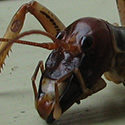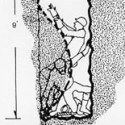|
Sockington posted:I'm re-doing a bunch of stuff in our 50yr old home that was built by the wife's grandfather. In the basement, there is a connection (one switch, one temperature control) to a sauna heater that is outside the house in an attached sauna. Yes. Pretty much everything dealing with pools, saunas, ponds, and fountains has to be on a GFCI or better.
|
|
|
|

|
| # ? May 13, 2024 00:26 |
|
drat this thread is long. I looked through and hope someone did not ask something similar... I bought a ceiling fan and wanted to replace my old ugly hanging lamp in my living room. The ceiling has 2 wires hanging down in the box. There is a white(neutral?) and there is a red(I am guessing hot?). There is also a black wire in there that is attached to another black wire that runs through that box to make it like one continuous wire that was not used for the old light. There is also two copper wires (grounds?) running in to this box from two openings in the sides of the box. They each are tied around a screw in there. The old lamp had the red from my ceiling attached to the light and the white wire to the old lamps white wire. It looked simple enough. The ceiling fan I bought has four wires. There is a black and blue (I am guessing one is for the light and one is for the fan motor, a white, and a green ground. So what I did is attached white to white, green to one of my copper grounds and the black and blue from the ceiling fan to the red wire in the ceiling using a marrette. It did not work and I cannot figure out what the hell is wrong with this setup. Is this continuous black wire inside the box supposed to come in to play here? All I want to do is use the light switch to give the whole unit power and use the pull chains to make the fan/lights go on and off. If it helps any, the light switch to control all this has a red wire and a black wire inside it. The red is the one when it is in the on position and the black is for when it is in the off position.
|
|
|
|
babyeatingpsychopath posted:Yes. Pretty much everything dealing with pools, saunas, ponds, and fountains has to be on a GFCI or better. That is what I was thinking, but wasn't sure if a heater would mess with the GFCI (never used electricity for heating in this fashion). Since Stab-Lock isn't available in a 30amp GFCI breaker (which my main panel is - Federal Pioneer Stab-Lock), I'm going to put in a small accessible sub-panel (only one double-throw breaker) with a Siemens 30amp GFCI before the power leaves the basement to the outdoor sauna. I knew something was fishy with how it was wired, but wanted to double check the whole heater + GFCI thing since it only runs on red/black/ground (and no neutral bus white).
|
|
|
|
aphid posted:drat this thread is long. I looked through and hope someone did not ask something similar... Your setup isn't working because you don't have the switch turned on. Here's your cables: black = always hot red = switched hot white = neutral bare = ground If you want, you could wire your fan to only have the switch operate the light, while the fan is independent of the switch. In that case you would use the fall pullchain to turn it on and off. To hook it up like that, you would just need to attach the fan lead to that black wirenut and the blue wire for the light to the red wire in the box. edit: here's how your wiring is set up. Power runs into your ceiling box first via its black wire. It's attached there to the black wire inside the run to the switch. That black wire is attached to the switch, where it sends power down the red wire in that same run back up to the ceiling box, where it powered a light. Since you have both an always hot and a switched hot in that ceiling box, you could use the switch to operate the fan, the light, or both. kid sinister fucked around with this message at 20:36 on Mar 29, 2011 |
|
|
|
A heater won't mess with a GFCI. I personally I would redo that Federal Pioneer service if I where you. They have been burning down buildings and almost got a recall: http://www.real-estate-news-articles.com/fire-hazard-federal-pacific-stab-lok-breaker-panels/ I would put a GFCI disconnect nearby the sauna, at least 5 feet away. Don't bother with a GFCI at the main panel, they will screw with each other if you put two in series on the same circuit. I also believe you have to have this per the NEC code.
|
|
|
|
kid sinister posted:Your setup isn't working because you don't have the switch turned on. Here's your cables: Ha, thanks, I feel like a complete idiot here. This is my first wiring aside from changing out outlets and lightswitches. To just get this straight so I don't gently caress anything up, I am going to attach those two black wires in the ceiling being held together with that little piece of metal to the black wire for my fan. How would you connect those to the wire? Do I need to undo them and then put all three together in a marrette or do I just put the black wire from my fan on to the little piece of metal holding those two black wires together with something else?
|
|
|
|
aphid posted:Ha, thanks, I feel like a complete idiot here. This is my first wiring aside from changing out outlets and lightswitches. Please take pictures or explain this little piece of metal, that doesn't sound good or right on hot wires. To connect them I'd spin all 3 together and put a marrette on them.
|
|
|
|
Messadiah posted:Please take pictures or explain this little piece of metal, that doesn't sound good or right on hot wires. I thought the wire nut the other guy said was what it was but looking at pictures, he was just using another word for a marrette. Don't have a camera here but it just kind of looks like this: code:
|
|
|
|
tworavens posted:A heater won't mess with a GFCI. I personally I would redo that Federal Pioneer service if I where you. They have been burning down buildings and almost got a recall: Ah, good to know about Stab-Lok. I've been in the panel a bunch of times and haven't noticed anything yet - but I will keep my eye on things and plan a service panel swap some weekend when I get a chance. We also have a 100amp Federal-Pioneer main service disconnect before the main panel - any issues with those? As for the breaker bit, I can't find a 220v@30amp GFCI outlet/receptable to wire inline. That's why I was going to have to go with a GFCI breaker in a sub-panel.
|
|
|
|
I did see some on ebay federal pacific gfcis on ebay, but they are used. Not sure that I would trust them. Basically going with a sub-panel is your best bet. You can get a GFCI disconnect for spas that is also fine for wet locations. Call up your local pool/spa supply store and see what they recommend.
|
|
|
|
Probably something like this, although that price is a little high. They also come in 30amp, but they're less common than the 50s.
|
|
|
|
I bought a foreclosure home recently in which all the lights and ceiling fans were removed by the exiting homeowner. Over the last month I've been replacing all the items room by room and have done all the fans and lights with no issue, until today. There is one last ceiling fixture in the "breakfast nook" just off the kitchen that looks like it used to have a pendant light attached (offset ceiling box, hook in center of seating area). The pan box is a metal unit attached directly to a ceiling joist but it seems too shallow to allow my pendant fixture which was getting moved from the dining room, it looks more like a ceiling fan box. The wires protruding through the center mount are pinned against the pan. Also, there are 7 wires coming out of the ceiling: 2 white, 2 black, 2 bare, and 1 red. I haven't run into this anywhere else in the house. This box is fed by what appears to be a Lutron dimmer you'd find at any Home Depot (see here). Its in a 2 gang box with another switch that controls the fluorescent kitchen lights. I checked the ceiling wires w/ a multimeter before and after I flipped the breaker. The dimmer definitely controlled that ceiling box, but I only read the black and white wires, leaving the red one untouched. I then connected the light to the pairs of black, white, and ground wires. Once I got everything together and hung, I turned power back on and tried the new light. I got nothing, no light. Any idea where I screwed up? Should I have done something with the red wire? I can provide pictures, if it helps.
|
|
|
|
I hate mystery wires. Did you try disassembling the suspected switch and examining it? And are sure there are no problems with the light? Its a dimmable bulb right? It sounds like it should work. Maybe switch the neutrals, idk. Post a picture so I can take a look.
|
|
|
|
Nemico posted:Probably something like this, although that price is a little high. They also come in 30amp, but they're less common than the 50s. That is what I was going to make with a simple sub-panel and a 30amp GFCI breaker. It'll run about $40cdn for the panel and $175cdn for the 30amp GFCI breaker.
|
|
|
|
vwman18 posted:I bought a foreclosure home recently in which all the lights and ceiling fans were removed by the exiting homeowner. Over the last month I've been replacing all the items room by room and have done all the fans and lights with no issue, until today. There is one last ceiling fixture in the "breakfast nook" just off the kitchen that looks like it used to have a pendant light attached (offset ceiling box, hook in center of seating area). The pan box is a metal unit attached directly to a ceiling joist but it seems too shallow to allow my pendant fixture which was getting moved from the dining room, it looks more like a ceiling fan box. The wires protruding through the center mount are pinned against the pan. Also, there are 7 wires coming out of the ceiling: 2 white, 2 black, 2 bare, and 1 red. I haven't run into this anywhere else in the house. This box is fed by what appears to be a Lutron dimmer you'd find at any Home Depot (see here). Its in a 2 gang box with another switch that controls the fluorescent kitchen lights. I checked the ceiling wires w/ a multimeter before and after I flipped the breaker. The dimmer definitely controlled that ceiling box, but I only read the black and white wires, leaving the red one untouched. I then connected the light to the pairs of black, white, and ground wires. Once I got everything together and hung, I turned power back on and tried the new light. I got nothing, no light. Any idea where I screwed up? Should I have done something with the red wire? I can provide pictures, if it helps.
|
|
|
|
Sockington posted:That is what I was going to make with a simple sub-panel and a 30amp GFCI breaker. It'll run about $40cdn for the panel and $175cdn for the 30amp GFCI breaker. Is the panel going to be inside? The one you linked isn't outdoor rated.
|
|
|
|
Nemico posted:Is the panel going to be inside? The one you linked isn't outdoor rated. The sauna is attached to the back of the house (addition the grandparents did). The linked panel will be installed in the basement of the house (dry location - living space) and then power sent outside (GFI protected before leaving the house) to the sauna heater. There's conduit that's been placed under the concrete to electrically connect the sauna to the rest of the house.
|
|
|
|
Not sure if this is the place for this, but seeing as a fair number of folks here are electricians: I work as a part time electrician for a small ski area in rural Manitoba. Part of our ski area is open for night skiing, lit by about 100 mercury vapor HID lamps @ 1000W each. The system was installed over 10 years ago, and is failing slowly - to the point where partial relamping is required every year, and is not solving the problem of dark areas (relamping can only be done in summer, and often by halfway through the open season many other lamps have failed). The ski area management have asked me to look into LED lighting, to see if it is feasible to replace some/many/all of the current fixtures with LED instead of relamping. Our current installation is single lamps at the top of a 20ft pole, angled downward. The area to light is anywhere up to 150ft wide, so I need a fixture that has a wide angle beam, but also throws the light forward a decent distance. Most LED solutions I have looked at appear to be for the street lighting market, where the fixture is able to be directly above the area to be lit. This is not possible in our scenario, as the poles must be on the edge of the ski terrain. I am wondering if anyone here has any experience with replacing 1000W flood lamps with LED fixtures? Does anyone know of any suppliers in Canada (or the US I guess) that carry these products?
|
|
|
|
I'm not sure they make anything that bright. But ask your local distributor about it. I'm surprised you guys are replacing those lights in sections, usually with big lighting projects like that I see people replacing every single light at once so that they don't have to do it at all for eight or ten years.
|
|
|
|
Crossposting from the quick questions thread, as it's fairly relevant and there may be some who perhaps don't read that thread, but could help me out. I'd like some help from whoever can kindly offer it, I'm trying to wire a plug to an old UK slide projector. I'm staying with my mum for the day, and in the loft we found a bunch of old slides. I also found the projector in the garage, but as you can see from the picture, at some point in the past the plug was removed. I can get hold of a new plug from somewhere, but my question is what kind of fuse should be used? I don't have much experience in this kind of thing, and don't want to break it. Underneath is written: 230-240V. 50HZ. A.C. ONLY 200W MAX. And then some other stuff including what kind of lamp to use. If anyone could shed some light on how best to do this, we would be really grateful.   Edit: will this be a 13A fuse? Manny Calavera fucked around with this message at 17:33 on Apr 2, 2011 |
|
|
|
At 240v 200w is 0.83a, if I'm not being a total idiot this morning. It seems your fuse should probably be a decent bit smaller than 13a in order to protect this device. Maybe an amp or two? Am I missing something, resident EEs/electricians?
|
|
|
|
chedemefedeme posted:At 240v 200w is 0.83a, if I'm not being a total idiot this morning. grover fucked around with this message at 20:42 on Apr 2, 2011 |
|
|
|
But the fuse in the cord wouldn't be so high, right? You'd want to practically limit it per device based upon a reasonable maximum draw? If thats so, and you'd really be fusing it at 1 or 2 amps...why don't we do this over here? On one hand it sounds like a big pain to have to swap fuses in devices all the time, but it also sounds safe to know that your lamp is fused for a 60w bulb instead of being ready to deliver 20a to your hand when malfunctions.
|
|
|
|
chedemefedeme posted:But the fuse in the cord wouldn't be so high, right? You'd want to practically limit it per device based upon a reasonable maximum draw?
|
|
|
|
Thanks for the replies. Had a look around, and we've only got a 13a fuse. I take it this would be inappropriate to use, and pose unnecessary risk? Next time I go shopping, exactly which fuse should I buy?
|
|
|
|
grover posted:Well, it's a pain in the rear end and adds cost, but it's nice that if you smash a lamp or something and it shorts out, it blows the fuse in the base instead of tripping the circuit breaker. Also allows devices to be built with smaller wire; devices in the US all must be built assuming a 20A breaker to pass UL listing. Its just very foreign to me. Never traveled there much less understood their electrical practices. The extra expense of the fuse/plug assembly vs the cheaper cord seems semi-pointless. I tend to just find it more convenient to go reset my breaker than I would having to go buy and replace a fuse...the less than one time a year I do something dumb enough to trip it. I'm a fan of integrated resettable breakers, though. Why aren't these used? Expense, I'd imagine? If cost weren't an option it seems the superior way to go. I guess it's why I see them on all the high end av/lighting production and power protection equipment I work with. Edit: further musings. With AFCI/GFCI breakers on everything in my house is it not safer to have thicker cords but no fuses on my lamps and devices compared to having thinner cords that can be compromised easier but carry the same voltage willing to hop out at you? This is why I realize my house is so elegant on the rare occasion I do something dumb. the AFCI catches things so fast I didn't even feel the slightest hint of shock last time I touched something dumb and set it off. I'm obviously not debating redoing my home to be like the UK, i'm just pondering it all for better understanding of their systems. chedemefedeme fucked around with this message at 21:43 on Apr 2, 2011 |
|
|
|
Something to add; the 13a fuse I took from an old battery charger from a 90s camcorder. It was labelled 100-240V~50-60Hz. As the projector is labelled 230-240V 50Hz, surely that's close enough?
|
|
|
|
Manny Calavera posted:Something to add; the 13a fuse I took from an old battery charger from a 90s camcorder. It was labelled 100-240V~50-60Hz. As the projector is labelled 230-240V 50Hz, surely that's close enough? You've listed voltages and frequencies but no current (amps) or power ratings (watts). There's simply not enough info to do math with.
|
|
|
|
eddiewalker posted:You've listed voltages and frequencies but no current (amps) or power ratings (watts). Ah, balls. The only other thing is that the projector's lamp is 150w. It probably uses further power in the mechanism that switches the slides. Would that help at all?
|
|
|
|
Your first post, with the pictures shows your projector rated at 200W. At 240V, that means it draws an amp or so. A 1A fuse will work here. Wikipedia says only 2 (black or blue), 3 (red), 5 (black or grey), 10 (black or yellow), and 13 (brown) amps are commonly found. 2A will work.
|
|
|
|
Manny Calavera posted:Ah, balls. The only other thing is that the projector's lamp is 150w. It probably uses further power in the mechanism that switches the slides. Would that help at all? grover fucked around with this message at 00:20 on Apr 3, 2011 |
|
|
|
In the US I see used slide projectors all the time for $1-5 at the Goodwill and consignment stores. It might be cheaper to just buy a whole new projector.
|
|
|
|
I know codes vary, but is it usually frowned upon/illegal to run an extra outlet into your A/C closet? Either the rear end in a top hat electrician or the rear end in a top hat Mediacom installer (I'm hoping the latter) ran all the coax pre-wire down out of the ceiling in the A/C closet. He didn't provide a smart-box either (which is fine, I'll build one at work since we have so much stainless laying around) but just left a rat's nest of splitters (which isn't so fine). I thought about making lemonade out of this and putting a little shelf in there for the cable modem and router, which would require running another outlet in there. Verboten/bad idea?
|
|
|
|
Too lazy to look in the NEC but I think the requirement is to have one insight or within 30' of your A/C unit. So putting an extra one in is okay. Just be warned they can be a bit of a pain in the rear end. Figure out how you are going to run the wire to if before you cut any holes. EDIT: It bugged me so I looked it up. NEC 2011 210.63 'The receptacle shall be on the same level and within 7.5m (25 ft) of the heating, air conditioning, and refrigeration equipment.' The only exception is if its a swamp cooler. I guess according to the rules you could probably get away with having one outside the area where your a/c unit is located. As long as it was within 25'. Try to figure out where the wires for the a/c unit are run through the wall so you can avoid them. And shut everything down before you start cutting. Thats my advice. tworavens fucked around with this message at 05:58 on Apr 3, 2011 |
|
|
|
Thanks very much for all the help given in regard to the fuses. As advised, I will go and buy a 2a fuse.
|
|
|
|
tworavens posted:Too lazy to look in the NEC but I think the requirement is to have one insight or within 30' of your A/C unit. So putting an extra one in is okay. Just be warned they can be a bit of a pain in the rear end. Figure out how you are going to run the wire to if before you cut any holes. It's not even a wall fish, really- there's nine RG-6 cables going down through the insulation over the closet. Another wire would be easy. Although I guess I was always trained not to co-mingle power and signal cables, so I could go down the other side where the 60A switch for the unit is. Another question- wife brought up the possibility of a bathroom TV (on a high wall mount overlooking the tub). I'm kinda for it since on a good swivel mount it can turn into a toilet TV as well. Do any and all outlets in the bathroom require a GFI?
|
|
|
|
Yes, yes and yes. Most especially if you're putting something over a tub. Install a quality one and test it with a little gfci tester. Edit: If the tv is directly over the water or any location a person would be standing I'd also be very safe and not only do a wall-mount on the TV but a safety chain; some method of catching the TV if the mount somehow looses it. Even if there's a GFCI nobody wants a tv falling on them while they're bathing/on a wet floor.
|
|
|
|
How can mounting a tv over the tub be code-compliant, if you can't even put a light switch within reach? I'd check into that. Maybe the tv can be inside a plexi panel in the wall, so it's waterproof, but a remote would work.
|
|
|
|
It wouldn't be directly over the tub but about 5' to the side and 6' up. The tether is a good idea (it'd only be a 13" flatscreen or so, but still); this is just a maybe project down the line.
|
|
|
|

|
| # ? May 13, 2024 00:26 |
|
So I have a pretty basic wiring question (I read through the whole thread, but didn't quite find my question covered, or if it was, I didn't understand). I am trying to run some new outlets in my basement. The previous owner of my house did some sort of 70's DIY finished basement covered in fake wood paneling. The wood paneling is attached to the basement walls in 2 ways: a) 1"x1"'s placed at random distances (no 16" on center or whatever here), with the paneling brad nailed to them, and b) panels adhered directly to the walls. There is no way I can run wires behind the walls, and no studs or whatever to fix things to, so can I just run some sort of flexible conduit and attach it to the paneling? What sort of conduit am I looking at, and what sort of outlet boxes? Also, do the answers differ if I need to run a 220v line? Thanks!
|
|
|

















